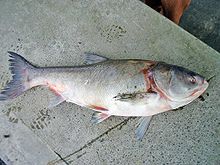Silver carp
From Wikipedia, the free encyclopedia
| Silver carp | |
|---|---|
 | |
| Conservation status | |
| Scientific classification | |
| Kingdom: | Animalia |
| Phylum: | Chordata |
| Class: | Actinopterygii |
| Order: | Cypriniformes |
| Family: | Cyprinidae |
| Genus: | Hypophthalmichthys |
| Species: | H. molitrix |
| Binomial name | |
| Hypophthalmichthys molitrix (Valenciennes, 1844) | |
The silver carp (Hypophthalmichthys molitrix) is a species of freshwater cyprinid fish, a variety of Asian carp native to north and northeast Asia. It is cultivated in China. Pound for pound, more silver carp are produced worldwide in aquaculture than any other species. They are usually farmed in polyculture with other Asian carps, or sometimes Indian carps or other species. It has been introduced to, or spread into via connected waterways, at least 88 countries around the world. The most common reason for importation was for use in aquaculture, but enhancement of wild fisheries and water quality control were also important reasons for importation.[1]
Diet [edit]
The silver carp is a filter feeder, and possesses a remarkably specialized apparatus capable of filtering particles as small as 4 micrometers (µm). The gill rakers are fused into a sponge-like filter, and an epibranchial organ secretes mucus which assists in trapping small particles. A strong buccal pump forces water through this filter. Silver carp, like all Hypophthalmichthys species, have no stomachs; they are thought to feed more or less constantly, largely on phytoplankton; they also consume zooplankton and detritus. Because of their plankton-feeding habits, there is concern they will compete with native planktivorous fishes, which in North America include paddlefish (Polyodon spathula), gizzard shad (Dorosoma cepedianum), and young fish of almost all species.
Because they feed on plankton, they are sometimes successfully used for controlling water quality, especially in the control of noxious blue-green algae(cyanobacteria). However, these efforts are sometimes not successful. Certain species of blue-green algae, notably the often toxic Microcystis, can pass through the gut of silver carp unharmed, and pick up nutrients while in the gut. Thus, in some cases, blue-green algae blooms have been exacerbated by silver carp. Also, Microcystis has been shown to produce more toxins in the presence of silver carp. These carp, which have natural defenses to their toxins, sometimes can contain enough algal toxins in their systems to become hazardous to eat.[2]

No comments:
Post a Comment